Azidothymidine (AZT, also called Zidovudine) is a nucleoside analog reverse-transcriptase inhibitor useful against the HIV virus. It was the first treatment to be developed and is still in use today. In this article I review this drug’s mechanism of action and explore how it can be prepared from thymidine through chemical synthesis.
The mechanism of action of AZT
HIV is a retrovirus – its virus particles encode its genetic information using single stranded RNA. However, human cells only have the enzymatic capability to make copies of DNA, not RNA. For retroviruses to be able to replicate in the host cell, they must encode a reverse transcriptase. By converting the viral RNA to double stranded DNA, this enzyme is required for copying the virus’s genetic material in newly infected cells. AZT acts to inhibit this essential process.
As suggested by its name, AZT is a structural analog of the nucleoside thymidine. The 3’ hydroxyl group of thymidine’s deoxyribose sugar is substituted with an azido group (N3). Thymidine is one of the four nucleosides used as the building blocks of DNA.
As suggested by its name, AZT is a structural analog of the nucleoside thymidine. The 3’ hydroxyl group of thymidine’s deoxyribose sugar is substituted with an azido group (N3). Thymidine is one of the four nucleosides used as the building blocks of DNA.
In the cell, the 5’ hydroxyl of each nucleoside’s deoxyribose sugar is activated as a nucleotide triphosphate. DNA synthesis occurs through iterative nucleophilic attacks of the DNA strand’s free 3’ hydroxyl end on the triphosphate of each incoming nucleotide, forming new phosphodiester bonds as shown below.
AZT can be incorporated into DNA in an analogous manner to thymine triphosphate. Though the drug is not administered in a phosphorylated form, it is enzymatically transformed into the triphosphate nucleotide in vivo [1]. The triphosphate derivative acts as a substrate for the HIV reverse transcriptase. Because this substrate lacks a 3’ hydroxyl group its incorporation prevents phosphodiester bond formation and further elongation of the DNA (chain termination). Blocking the synthesis of full-length DNA inhibits viral replication. However, toxicity is a concern with this mechanism, since it may also inhibit DNA synthesis in healthy cells. Fortunately, it is selective with roughly 100-fold more activity against HIV reverse transcriptase than human DNA polymerases [2].
Though AZT is usually effective at retarding viral replication, the strategy is vulnerable to the development of resistance. Mutations in the HIV reverse transcriptase can improve its ability to distinguish between a hydroxyl and azido substituent at the 3’ position, selectively reducing the inhibitor’s binding and activity [3]. Furthermore, a reverse transcriptase-catalyzed ATP-dependent base excision mechanism has been described, where the chain terminating AZT monophopshate is cleaved from the DNA’s 3’ end [4]. Therefore, AZT is usually given in combination with one or more other anti-viral drugs to mitigate this possibility.
Synthesis of azidothymidine from thymidine
Given its structural analogy with thymidine, this biomolecule is a convenient starting point for the organic synthesis of Zidovudine. Converting thymidine to AZT requires substitution of the 3’ hydroxyl with an azido group while avoiding modification of the 5’ hydroxyl. Hydroxyl groups can be replaced with azide by activating them as a good leaving group followed by an SN2 displacement. This mechanism inverts the stereochemistry of the center, complicating the synthesis since thymidine’s original stereochemistry must be maintained in the product.
In the first published synthesis of AZT [5], the 5’ hydroxyl of thymidine was protected with a trityl group. The steric bulk of trityl chloride makes it highly selective for primary alcohols, leaving the more sterically encumbered secondary 3’ hydroxyl unmodified. The stereochemistry at the 3’ position was preserved by two sequential SN2 reactions. Activation of the 3’ hydroxyl as a mesylate (2) and hydrolysis gave inverted stereochemistry at this position. A second activation of the hydroxyl as a mesylate (3) and nucleophilic displacement with lithium azide yielded the azido substituent with conservation of thymidine’s stereochemistry (4). Deprotection of the trityl group under acidic conditions gave AZT.
In the first published synthesis of AZT [5], the 5’ hydroxyl of thymidine was protected with a trityl group. The steric bulk of trityl chloride makes it highly selective for primary alcohols, leaving the more sterically encumbered secondary 3’ hydroxyl unmodified. The stereochemistry at the 3’ position was preserved by two sequential SN2 reactions. Activation of the 3’ hydroxyl as a mesylate (2) and hydrolysis gave inverted stereochemistry at this position. A second activation of the hydroxyl as a mesylate (3) and nucleophilic displacement with lithium azide yielded the azido substituent with conservation of thymidine’s stereochemistry (4). Deprotection of the trityl group under acidic conditions gave AZT.
A more efficient AZT synthesis
The previous synthesis was inefficient in that the 3’ hydroxyl had to be activated and displaced twice to achieve the desired stereochemistry. An innovative approach greatly simplified this: two tandem Mitsunobu reactions [6]. The first reaction activated the 5’ hydroxyl and installed a p-methoxylbenzoyl ester as a protecting group. The second Mitsunobu reaction activated the 3’ hydroxyl, followed by neighboring group participation from the thymine C2-oxygen. The resulting 2,3’-anyhdro derivative conveniently has an activated 3’ position and inverted stereochemistry (5) over a single step. Opening the anhydro linkage with an azide SN2 furnished the 3’ azido group (6). Treatment of this product with basic methanol cleaved the p-methoxybenzoyl protecting group, yielding AZT.
Given its novelty and importance for this synthetic strategy, I conclude by reviewing the Mitsunobu reaction mechanism responsible for formation of the 2,3’ anhydro linkage. First, triphenyl phosphine (PPh3) attacks diethyl azodicarboxylate, forming a betaine intermediate. Protonation of this species is followed by nucleophilic attack by the 3’ hydroxyl on the phosphonium ion, activating it as a good leaving group. The transformation concludes with expulsion of the oxyphosphonium by intramolecular attack by the C2-oxygen of the thymine ring, affording product 5.
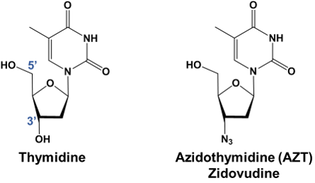
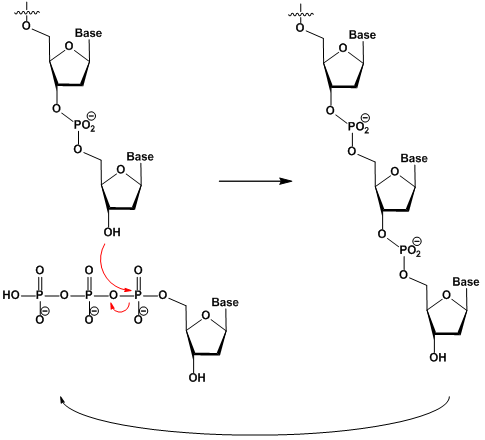
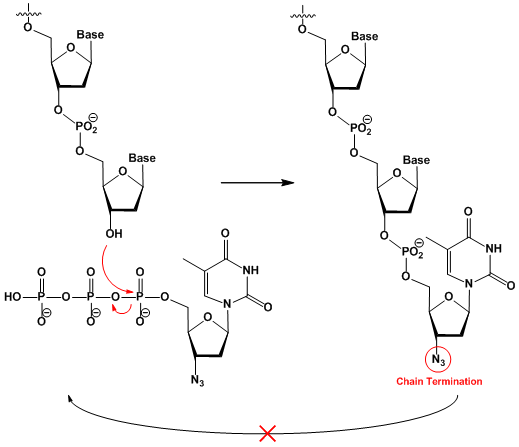
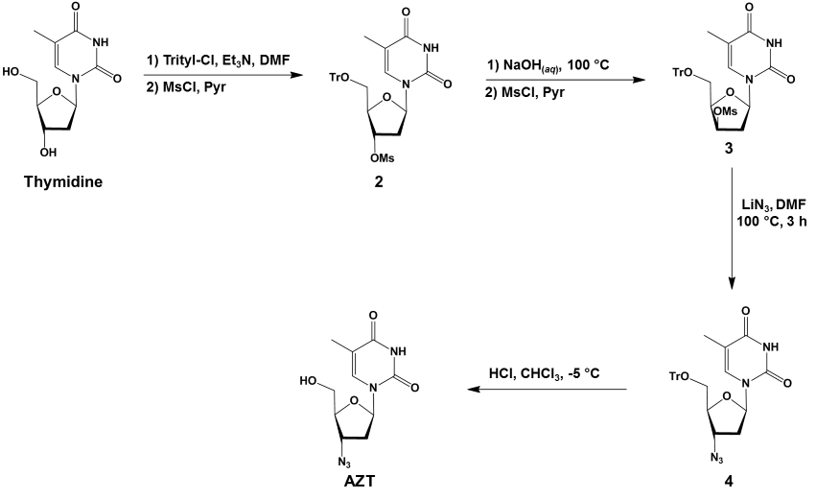
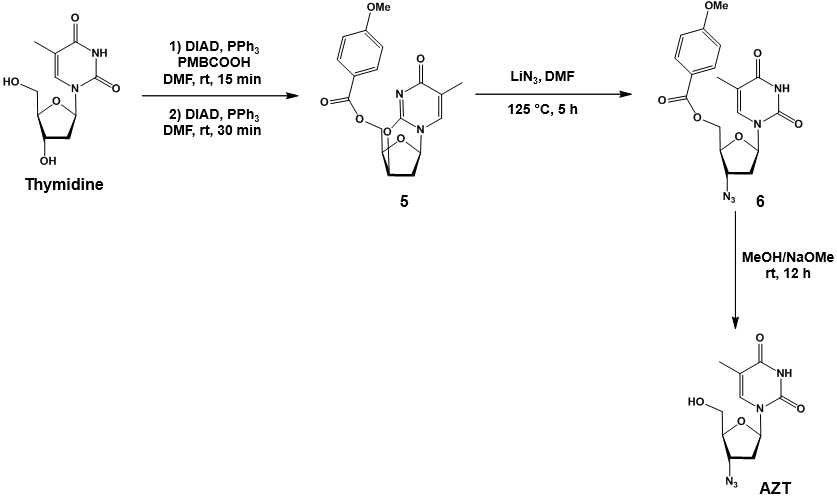
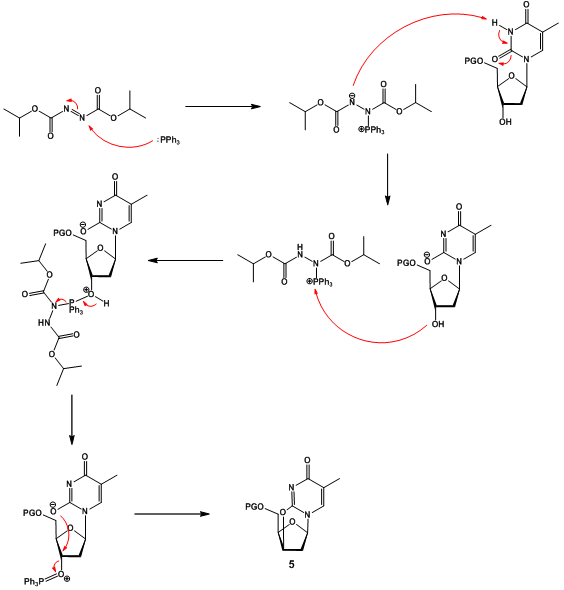
 RSS Feed
RSS Feed